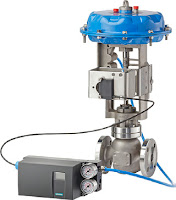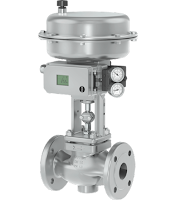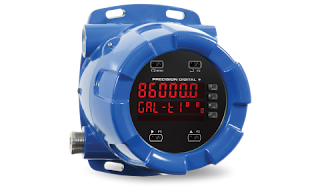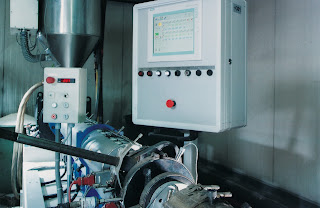Front, back and in between, the PD8-6000 explosion-proof process meter boasts specifications, features and functionality that make it the only hazardous area process meter you will ever need.
The PD8-6000 is approved as a complete product by FM and CSA and also carriers IECEx approvals. Besides being suitable for hazardous areas, the number one feature that makes the PD8-6000 such a useful device is its built-in 24 VDC power supply to drive the transmitter as illustrated by the above diagram. This feature not only saves the cost of an external power supply, but also greatly simplifies wiring. In addition, there is a second 25 mA power supply provided with the 4-20 mA output option
Its superluminous LED digits make it easily readable in smoke, dust, fog, and, with the optional SunBright® display, even direct sunlight. It accepts a process current (4-20 mA) or process voltage (0-5V, 1-5V, etc.) signal and displays it on a dual-line, 6-digit SunBright® sunlight readable display.
The meter includes a 24 VDC power supply to drive the transmitter and can be equipped with up to four internal relays and a 4-20 mA output. The PD8-6000 can be programmed and operated without opening the housing by using the built-in SafeTouch® through-glass buttons or the RS485 serial communication port with free Modbus® protocol.
A fully loaded PD8-6000 meter has the following: four SPDT relays, 4-20 mA output, and two 24 VDC power supplies. The four relays can be used for alarm indication or process control applications such as pump alternation control. The 4-20 mA isolated output, Modbus RTU serial communications, and digital I/O options make the PD8-6000 an excellent addition to any hazardous area application.
For more information, contact Ives Equipment by calling 877-768-1600 or by visiting https://ivesequipment.com.
Educational information on process control, industrial instrumentation, valves, valve automation and control valves. For additional information visit IvesEquipment.com or call 877-768-1600
Reducing Material Waste in Flexible Pet (Polyethylene Terephthalate) Production
Polyester is very popular because it is a light, soft, flexible, low-maintenance material that keeps you warm. Making it this way poses diverse challenges to PET producers.
A chemical plant specializing in producing PET was looking for a solution to reduce the waste resulting from product variance. The factory produces 25,000 tons of polyester annually, which is then provided to other manufacturers to produce a vast range of end products.
 |
| The SITRANS FC430 monitors the glycol flow. |
These source materials are stored in stainless steel bins with a volume of 2649 ft3. Rotary feeders move the mate- rial from these bins to a batching vessel along with glycol to make the polyester paste. The batching vessel is agitated to ensure that the mixture is always consistent. Monitoring tank levels, precisely controlling the dosing, the efficient use of raw materials and ensuring a consistent mix are the key parameters
 |
| SIWAREX WP251 |
Don’t get mixed up during mixing
Each raw material bin is mounted on Siwarex WL280 ring torsion load cells to achieve optimum weighing accuracy. These load cells are connected to two Siwarex WP251 weighing modules, which are specifically designed for batching applications. The advantages of this solution are that the WL280 load cells feature a C3 class rating for accuracy as well as an IP68 rating for protection against dust and direct high-pressure cleaning – ideal for handling powder materials such as PTA. In connection with the Siwarex WP251, a customer-specific application was engineered with a resolution of up to +/- 4 million parts.
 |
| SITRANS TS500 |
How powder and liquid become PET
 |
| Pointek CLS200 |
Less material waste and reduced downtimes
 |
| SIPART PS2 |
 |
| Simplified diagram showing the customer’s process. |
Ives Equipment
877-768-1600
https://ivesequipment.com
Oil & Gas and Power Grids Have New "Cause for Concern" from Hackers
A report released in June, from the security firm Dragos, describes a worrisome development by a hacker group named, “Xenotime” and at least two dangerous oil and gas intrusions and ongoing reconnaissance on United States power grids.
Multiple ICS (Industrial Control Sectors) sectors now face the XENOTIME threat; this means individual verticals – such as oil and gas, manufacturing, or electric – cannot ignore threats to other ICS entities because they are not specifically targeted.
The Dragos researchers have termed this threat proliferation as the world’s most dangerous cyberthreat since an event in 2017 where Xenotime had caused a serious operational outage at a crucial site in the Middle East.
The fact that concerns cybersecurity experts the most is that this hacking attack was a malware that chose to target the facility safety processes (SIS – safety instrumentation system).
For example, when temperatures in a reactor increase to an unsafe level, an SIS will automatically start a cooling process or immediately close a valve to prevent a safety accident. The SIS safety stems are both hardware and software that combine to protect facilities from life threatening accidents.
At this point, no one is sure who is behind Xenotime. Russia has been connected to one of the critical infrastructure attacks in the Ukraine. That attack was viewed to be the first hacker related power grid outage.
This is a “Cause for Concern” post that was published by Dragos on June 14, 2019.
“While none of the electric utility targeting events has resulted in a known, successful intrusion into victim organizations to date, the persistent attempts, and expansion in scope is cause for definite concern. XENOTIME has successfully compromised several oil and gas environments which demonstrates its ability to do so in other verticals. Specifically, XENOTIME remains one of only four threats (along with ELECTRUM, Sandworm, and the entities responsible for Stuxnet) to execute a deliberate disruptive or destructive attack.
XENOTIME is the only known entity to specifically target safety instrumented systems (SIS) for disruptive or destructive purposes. Electric utility environments are significantly different from oil and gas operations in several aspects, but electric operations still have safety and protection equipment that could be targeted with similar tradecraft. XENOTIME expressing consistent, direct interest in electric utility operations is a cause for deep concern given this adversary’s willingness to compromise process safety – and thus integrity – to fulfill its mission.
XENOTIME’s expansion to another industry vertical is emblematic of an increasingly hostile industrial threat landscape. Most observed XENOTIME activity focuses on initial information gathering and access operations necessary for follow-on ICS intrusion operations. As seen in long-running state-sponsored intrusions into US, UK, and other electric infrastructure, entities are increasingly interested in the fundamentals of ICS operations and displaying all the hallmarks associated with information and access acquisition necessary to conduct future attacks. While Dragos sees no evidence at this time indicating that XENOTIME (or any other activity group, such as ELECTRUM or ALLANITE) is capable of executing a prolonged disruptive or destructive event on electric utility operations, observed activity strongly signals adversary interest in meeting the prerequisites for doing so.”
Multiple ICS (Industrial Control Sectors) sectors now face the XENOTIME threat; this means individual verticals – such as oil and gas, manufacturing, or electric – cannot ignore threats to other ICS entities because they are not specifically targeted.
The Dragos researchers have termed this threat proliferation as the world’s most dangerous cyberthreat since an event in 2017 where Xenotime had caused a serious operational outage at a crucial site in the Middle East.
The fact that concerns cybersecurity experts the most is that this hacking attack was a malware that chose to target the facility safety processes (SIS – safety instrumentation system).
For example, when temperatures in a reactor increase to an unsafe level, an SIS will automatically start a cooling process or immediately close a valve to prevent a safety accident. The SIS safety stems are both hardware and software that combine to protect facilities from life threatening accidents.
At this point, no one is sure who is behind Xenotime. Russia has been connected to one of the critical infrastructure attacks in the Ukraine. That attack was viewed to be the first hacker related power grid outage.
This is a “Cause for Concern” post that was published by Dragos on June 14, 2019.
“While none of the electric utility targeting events has resulted in a known, successful intrusion into victim organizations to date, the persistent attempts, and expansion in scope is cause for definite concern. XENOTIME has successfully compromised several oil and gas environments which demonstrates its ability to do so in other verticals. Specifically, XENOTIME remains one of only four threats (along with ELECTRUM, Sandworm, and the entities responsible for Stuxnet) to execute a deliberate disruptive or destructive attack.
XENOTIME is the only known entity to specifically target safety instrumented systems (SIS) for disruptive or destructive purposes. Electric utility environments are significantly different from oil and gas operations in several aspects, but electric operations still have safety and protection equipment that could be targeted with similar tradecraft. XENOTIME expressing consistent, direct interest in electric utility operations is a cause for deep concern given this adversary’s willingness to compromise process safety – and thus integrity – to fulfill its mission.
XENOTIME’s expansion to another industry vertical is emblematic of an increasingly hostile industrial threat landscape. Most observed XENOTIME activity focuses on initial information gathering and access operations necessary for follow-on ICS intrusion operations. As seen in long-running state-sponsored intrusions into US, UK, and other electric infrastructure, entities are increasingly interested in the fundamentals of ICS operations and displaying all the hallmarks associated with information and access acquisition necessary to conduct future attacks. While Dragos sees no evidence at this time indicating that XENOTIME (or any other activity group, such as ELECTRUM or ALLANITE) is capable of executing a prolonged disruptive or destructive event on electric utility operations, observed activity strongly signals adversary interest in meeting the prerequisites for doing so.”
Calibration Services for Process Instrumentation
Measuring, positioning, recording, and controlling are important parameters in all industries processes. That’s why process instruments need to deliver the highest levels of precision and reliability.
Today calibration measuring devices is an important production and competitive activity due to steadily increasing demands on reliability, availability and performance.
Off-site Calibration Services
Siemens offers factory calibration services for Pressure, Temperature and Flowmeters from both our own and other manufacturers.On-site Calibration Services
Siemens offers on-site calibrations for Pressure, Temperature and Belt scale of our own products as well as those of other manufacturers.This video presents the viewer with explanations and concepts for the following:
- The Siemens Process Instrument Services overview.
- A description of field instrument technologies.
- What calibration means.
- Reasons for calibrating field devices.
- The importance of calibration and verification.
- What traceability means.
- Why accreditation is needed.
- The Siemens Factory Calibration process.
- The Siemens On-site Calibration process.
- What verification means.
- Reasons for verification.
- The Siemens On-site Verification process.
For more information, contact Ives Equipment:
(877) 768-1600
https://ivesequipment.com
Labels:
Calibration,
Delaware,
Maryland,
New Jersey,
New York,
Pennsylvania,
Siemens,
Verification,
Virginia
What Are Pneumatic Actuators?
 |
| Internal view of rack and pinion actuator (Flowserve Worcester) |
Pneumatic valve actuators are used in extreme conditions in many industries such as oil and gas, chemical, water and wastewater, bulk storage, pulp & paper, and power generation. These devices are used in a multitude of valve control processes for regulation (or cessation) of flow, controlling pressure and adjusting level. Due to their reliability and simplicity, pneumatic actuators are one of the most popular types of actuators used in industry today.
Pneumatic valve actuators work by conversion of air pressure into motion. The device applies a force of air to a diaphragm, rotary vane, or piston that is attached to the actuator shaft, which is then mechanically connected to the stem of the valve or damper. Depending on the type, pneumatic actuators produce either linear or rotary motion.
ACTUATOR ACTION - SPRING RETURN OR DOUBLE ACTING
Spring Return — Pneumatic actuators with spring return design have air supplied from one side. The spring on the opposite side is responsible for the motion. With this design, air compression moves the opens or shuts the valves while the spring is responsible for the opposite motion.
Double Acting — Double acting actuators have air fed on both sides of a piston. The pressure on one side is higher as compared to the other that results in the required in movement. Air is used to open and close the valves.
 |
| Diaphragm actuator (Samson) |
PNEUMATIC ACTUATOR DESIGNS
Diaphragm Actuators — Diaphragm actuators work by applying pressure to a thin membrane or diaphragm.
Piston Actuators — Piston actuators apply compress air to a piston that is within a cylinder. Air is fed into a chamber that moves the piston in one direction. The piston moves in the opposite direction when air pressure is removed (spring assisted) or directed to the other side (double acting).
Rack and Pinion — Rack and pinion actuators produce rotation by applying pressure to pistons with gears that turn a pinion gear. Rack and pinion actuators can be spring return or double acting. They are valued because of their compact size and versatility.
Scotch Yoke — A scotch-yoke actuator contains a piston, yoke, connecting shaft, and rotary pin.
They can be direct acting or spring return. They are capable of providing very high torque outputs and are generally used on larger valves. Scotch yoke actuators can be powered by air or process gas.
 |
| Scotch yoke actuator (Samson) |
Rotary Vane —Vane actuators use a mechanical vane, connected to a shaft, that separates a circular shaped body in two "clamshell" halves. The vane moves in response to the differential pressure inside the actuator body, turning the shaft clockwise or counter-clockwise in response to the pressure differential. External springs units are available for spring return models.
BENEFITS OF PNEUMATIC ACTUATORS
The use of compressed air (typically found in all industrial facilities) as the power source is the prime advantage for the use of pneumatic actuators. Additionally, pneumatic actuators have an advantage in suitability for different environments and can be used in extremes temperatures. They are preferred over electrical actuators in explosive, flammable and other hazardous areas because they do not require electricity (a possible ignition source) to operate. They do not create electrical fields or electrical noise since there is no electrical motor. Pneumatic valve actuators are faster opening and closing compared to their electric counterparts. Finally, they are low cost, lightweight, durable, require little maintenance (depending on quality) and there are a myriad of positioning controls, speed controls, and communications devices available for tailoring the actuator to the application.
DRAWBACKS OF PNEUMATIC ACTUATORS
While compressed air is the main reason for using pneumatic actuators, it can also be considered a drawback. For instance, pneumatic actuators can perform poorly when the air supply source is located at a distance, resulting in lag and slow response. Another drawback of pneumatic actuators is the additional cost for the compressed air system due to the requirement of dust filters and moisture removing dryers. These are required to ensure clean air is fed into the system.
APPLYING PNEUMATIC ACTUATORS
There are many aspects to the proper, safe, and efficient application of pneumatic actuators to valves and dampers. Sizing the power output (torque) being paramount. All valves and dampers have unique torque requirements. You must consider a threshold force for opening (breakaway), as the valve continues to move to its open or closed position, and then for seating. Matching the actuators to the valve type, and operating conditions is critical. Published torque curves must be reviewed and understood. Too little torque and the vale will not respond. Too much torque increases cost and can damage the valve. Spring return adds to this complexity. Considering all this, it is strongly suggested you always discuss any valve actuation requirement with an experienced applications expert. They will ensure the proper, safe, and cost effective mating of pneumatic actuator to valve or damper.
Labels:
Delaware,
Maryland,
New Jersey,
New York,
Pennsylvania,
pneumatic actuator,
valve actuation,
Virginia
Subscribe to:
Posts (Atom)




